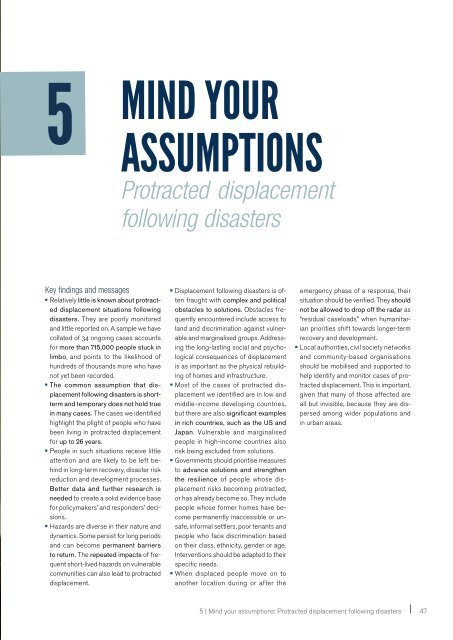Estimates
bzTPL9
bzTPL9
- No tags were found...
You also want an ePaper? Increase the reach of your titles
YUMPU automatically turns print PDFs into web optimized ePapers that Google loves.
5MIND YOURASSUMPTIONSProtracted displacementfollowing disastersKey findings and messagesRelatively little is known about protracteddisplacement situations followingdisasters. They are poorly monitoredand little reported on. A sample we havecollated of 34 ongoing cases accountsfor more than 715,000 people stuck inlimbo, and points to the likelihood ofhundreds of thousands more who havenot yet been recorded.The common assumption that displacementfollowing disasters is shorttermand temporary does not hold truein many cases. The cases we identifiedhighlight the plight of people who havebeen living in protracted displacementfor up to 26 years.People in such situations receive littleattention and are likely to be left behindin long-term recovery, disaster riskreduction and development processes.Better data and further research isneeded to create a solid evidence basefor policymakers’ and responders’ decisions.Hazards are diverse in their nature anddynamics. Some persist for long periodsand can become permanent barriersto return. The repeated impacts of frequentshort-lived hazards on vulnerablecommunities can also lead to protracteddisplacement.Displacement following disasters is oftenfraught with complex and politicalobstacles to solutions. Obstacles frequentlyencountered include access toland and discrimination against vulnerableand marginalised groups. Addressingthe long-lasting social and psychologicalconsequences of displacementis as important as the physical rebuildingof homes and infrastructure.Most of the cases of protracted displacementwe identified are in low andmiddle-income developing countries,but there are also significant examplesin rich countries, such as the US andJapan. Vulnerable and marginalisedpeople in high-income countries alsorisk being excluded from solutions.Governments should prioritise measuresto advance solutions and strengthenthe resilience of people whose displacementrisks becoming protracted,or has already become so. They includepeople whose former homes have becomepermanently inaccessible or unsafe,informal settlers, poor tenants andpeople who face discrimination basedon their class, ethnicity, gender or age.Interventions should be adapted to theirspecific needs.When displaced people move on toanother location during or after theemergency phase of a response, theirsituation should be verified. They shouldnot be allowed to drop off the radar as“residual caseloads” when humanitarianpriorities shift towards longer-termrecovery and development.Local authorities, civil society networksand community-based organisationsshould be mobilised and supported tohelp identify and monitor cases of protracteddisplacement. This is important,given that many of those affected areall but invisible, because they are dispersedamong wider populations andin urban areas.5 | Mind your assumptions: Protracted displacement following disasters47


